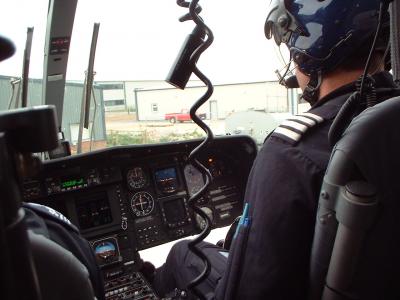Visual Cues When Hovering Helicopters
(Reviewed on 1st March 2021)
Visual Cues
The next time you watch a helicopter take off and lift into the hover and it takes off smoothly and comes to a really steady hover; ask yourself how the pilot is holding everything so steady. The main reason is lots of practice. Good co-ordination and muscle memory definitely make things easier but with the practice he/she has also developed a scan outside that allows him/her to see any movements of the helicopter. The pilot is not fixated on one individual point during the helicopter take off. Instead, he/she will be looking at various points; some close, some far away and some of these points will be in his peripheral vision.
Developing a Scan
When you are learning how to hover a helicopter it is a common mistake to start looking closer to the helicopter and you may soon find yourself fixated on a blade of grass only a few meters from the aircraft. At about this time, your instructor will remind you to look well ahead. But where do you look? Looking close to the helicopter will help you maintain your position but it will not help you overcome the instability of the helicopter. Looking ahead will allow you to hold a steady hover.
As I said earlier, you cannot fixate on one point. You have to develop a scan. How?
The next time you go to the cinema or in front of a large TV, try to note how you watch the action on the large screen. You do not continually move your head. Your head remains stationary while your eyes move. Your eyes are drawn to where the peripheral movement or action is occurring. We can use this type of scan in the helicopter.
Unlike the scan in the cinema, the helicopter scan will not have peripheral movement or action to draw your attention. You are going to have to find objects to look at. Imagine you are sitting in the cinema or in front of a large TV. Look outside and what do you see? Look for things over a wide field of view without moving your head. For example, the wind sock, the control tower, parked aircraft; or further away, hills or identifiable features on the horizon. This scan is not a natural scan like the one you use when watching TV. It has to be developed and this is done through practice. You have to actively look for the objects you are going to scan while hovering.
When you are taking off in a helicopter you need to have your head upright. Make sure your eyes scan from side to side and pick out several of the features you have chosen. These should remain in the same relative position as you take off into a hover.
While you are hovering helicopters, you must continue your scan to keep the features steady. If you can manage to do this, you will end up having a stable hover and you will be doing it with very little effort. Once you have developed your scan, you become a much safer pilot. You now have the ability to come safely to a hover out of ground effect. When navigating on a cross-country trip, you can now hold up a chart and read it while still maintaining your attitude and heading using your peripheral vision.
Each one of your helicopter take offs and landings should be safe and smooth. If you are flying properly, your passengers will think that anyone can fly a helicopter because you make it look so easy and it appears as if you are doing very little. If you do it wrong, your passengers will feel unsafe and will not want to fly with you again. When they say they want to go flying with you again, you will know that you have had a great flight.
Did you enjoy this post? Why not leave a comment below and continue the conversation, or subscribe to my feed and get articles like this delivered automatically to your feed reader.









Hey there, I usually don’t comment but figured I would do it now. Plain and simple I like your blog.